NORTH WALES COAST RAILWAY:NOTICE BOARD
Rheilffordd arfordir gogledd Cymru: Hysbysfwrdd
25 July 2016
Share on Twitter
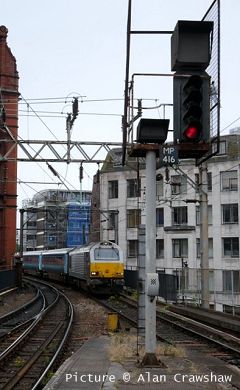
Tweets by @NWrail1
Contributions and comments are encouraged: see the Contributions Page
This list may be out of date if you are reading an archived issue. For full information visit our Calendar page.
July 2016
Tuesday 26 July Railway Touring Company THE WELSH MOUNTAINEER Preston - Blaenau Ffestiniog . Steam loco 45305 or 48151: Preston - Chester - Blaenau Ffestiniog and return
August 2016
Sunday 21 August Railway Touring Company THE NORTH WALES COAST EXPRESS Crewe - Manchester - Holyhead (WCRC) Steam loco 45690 or 46115: Manchester - Chester - Holyhead and return
September 2016
Sunday 4 September Railway Touring Company THE NORTH WALES COAST EXPRESS Crewe - Manchester - Holyhead (WCRC) Steam loco 45690 or 46115: Manchester - Chester - Holyhead and return
Friday 30 September Great Western Society North West Branch. Steam in Black and White. Peter Spilsbury.
October 2016
Friday 28 October Great Western Society North West Branch. Railway Personnel. Paul Shackcloth.
November 2016
Friday 25 November Great Western Society North West Branch. GW Steam in S. Wales and S West. Alf Storey
December 2016
January 2017
Friday 27 January Great Western Society North West Branch. North of Preston Barrie Rushton
February 2017
Friday 24 February Great Western Society North West Branch. Group AGM
March 2017
Friday 31 March Great Western Society North West Branch. (To be announced)
April 2017
Friday 28 April Great Western Society North West Branch. (To be announced)
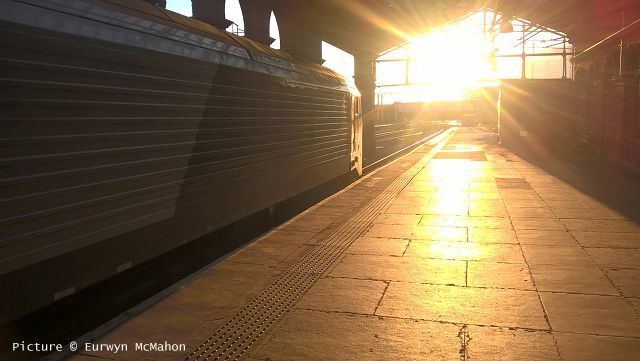
Silver and Gold as 67 012 pauses at Chester with the 19:34 Llandudno - Crewe train, 4 July. Picture by Eurwyn McMahon.
'Eisteddfod' to visit Eisteddfod
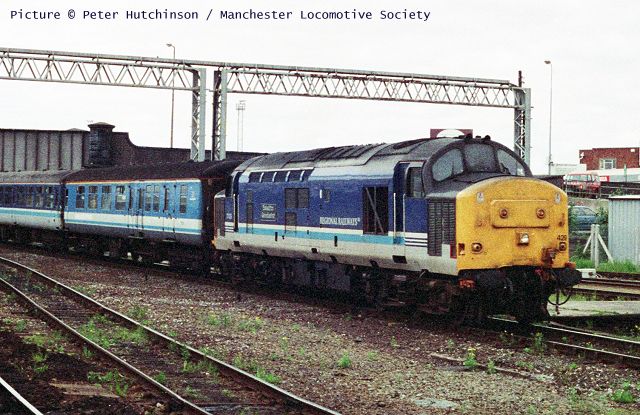
Following on from our item last issue about the nameplates of 37 429 Eisteddfod Genedlaethol, Dafydd Roberts, Keeper, of the National Slate Museum in Llanberis write to tell us that the nameplate acquired by Amgueddfa Cymru-National Museum Wales will be displayed on the Museum's stand in 'Y Lle Hanes' at this year's National Eisteddfod in Abergavenny, but on the final Saturday of the Eisteddfod - Saturday 6 August. Restoration work on it is almost complete, and Amgueddfa Cymru's Transport Curator, Dr David Jenkins, has prepared an accompanying panel looking at the history of the use of Class 37 locomotives in Wales.
An excuse for another 37/4 picture: The view above, taken c. 1994 by the late Peter Hutchinson and now in the care of the Manchester Locomotive Society, shows 37 429 in its black-nameplate days arriving at Chester from North Wales. Behind the loco is one of the coaches transferred from the Waterloo - Exeter line, and still in Network SouthEast colours with the red lower stripe converted to blue. Does anyone know when the last of these received full Regional Railways colours?
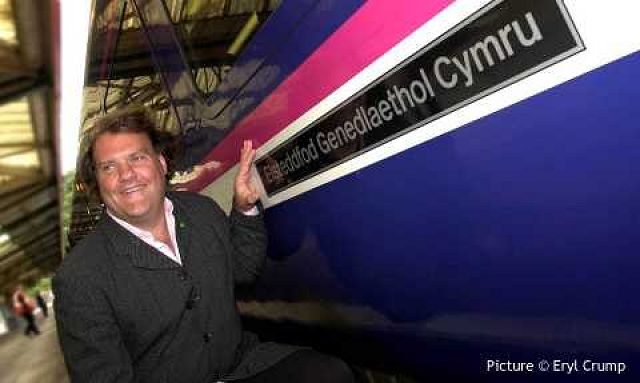
Dafydd also reminds us that railcar 175 003 was named Eisteddfod Genedlaethol Cymru by Bryn Terfel, at a ceremony held at Bangor station during the 2005 National Eisteddfod. Above is Eryl Crump's picture of the occasion from our archives. The name was applied to the unit whilst still in the colours of the First North Western company as a vinyl sticker, but does not appear to have survived the repainting into Arriva livery a few years later.
Arriva seem to dismiss the idea naming of rolling stock, despite the publicity value of the naming ceremony; it will be a shame if their takeover of the Northern fleet results in the loss of the many interesting names worn by units in that fleet. It's probably best not to hold a public competition for a name though: that resulted in 175 103 being christened Mum.
North Wales Coast Express
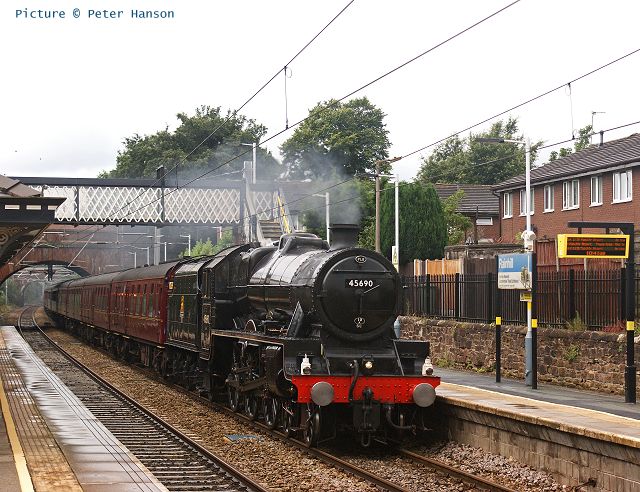
24 July saw the commencement of this summer's series of Railway Touring Company 'North Wales Coast Express ' steam excursions with a run by 45690 Leander from Liverpool Lime Street to Llandudno and Holyhead. We pick up the train (1Z95. 10:04 from Liverpool) at Rainhill, with George Stephenson's famous skew bridge in the background. Picture by Peter Hanson.
Although ultimately the name Leander comes from classical mythology, like sister loco Galatea the loco was one of a series named after warships. In this case HMS Leander a light cruiser completed in 1933, as the fifth Royal Navy ship to carry the name, which was first used for a warship in 1780. The name passed to a frigate launched in 1961, which was eventually sunk while being used for target practice in 1989.
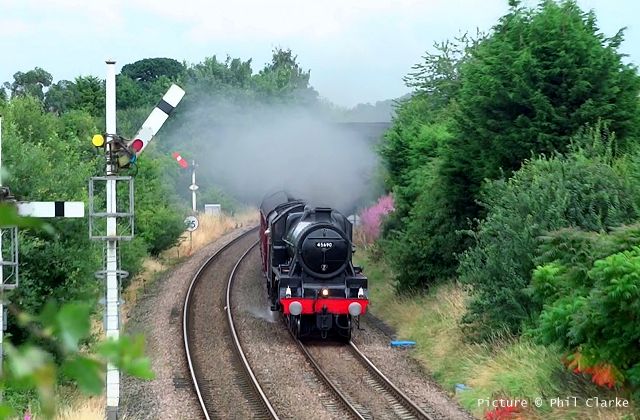
Helsby (Phil Clarke). Train crews here have to be on the lookout for the signal which is on the fireman's side of the train for sighting purposes when rounding the curve, a vital part of their 'route knowledge.'
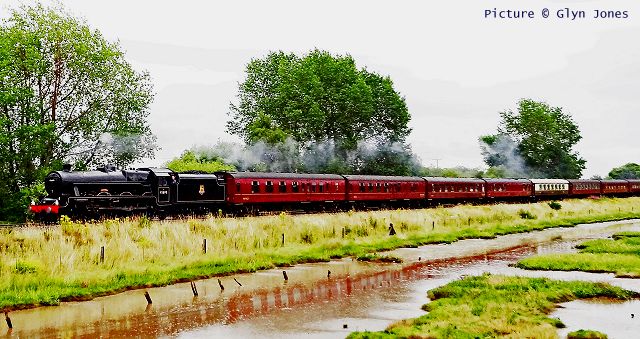
Passing the flushing pools at Bagillt, the coaching stock reflecting in the water following a heavy shower. Note the two 'brake-end' coaches behind the loco; the first one is the support coach (Glyn Jones).
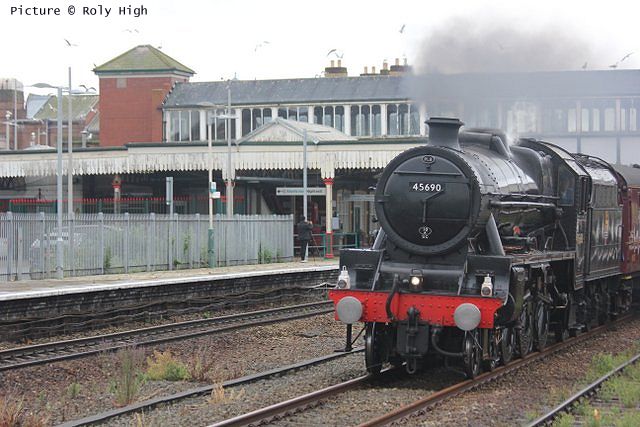
Rhyl (Roly High).
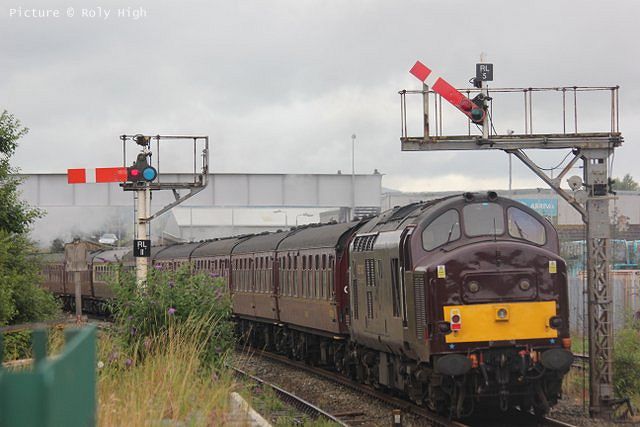
On the rear, in place of the more usual Class 47 or 57 used by West Coast Railways on tail-end Charlie duty, 37 668, which seems to have a rather squashed face (Roly High). This is one of the two West Coast locos, the other being 37 669, which are fitted with Hitachi ERTMS signalling equipment for use on the Cambrian lines. The Doppler radar and balise (transducer) antenna equipment has been fitted by re-designing one of the underfloor fuel tanks. 37 668 was tested on the Cambrian lines a few months ago, but we have hear of no revenue-earning work by either loco on ERTMS-fitted routes. Here is a link to an article by the people who carried out the work.
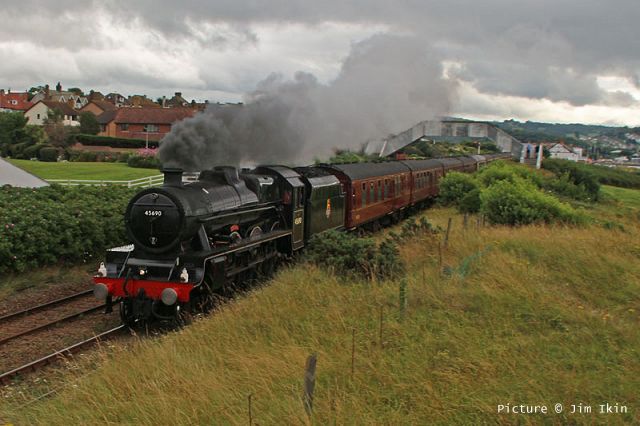
Deganwy (Jim Ikin).
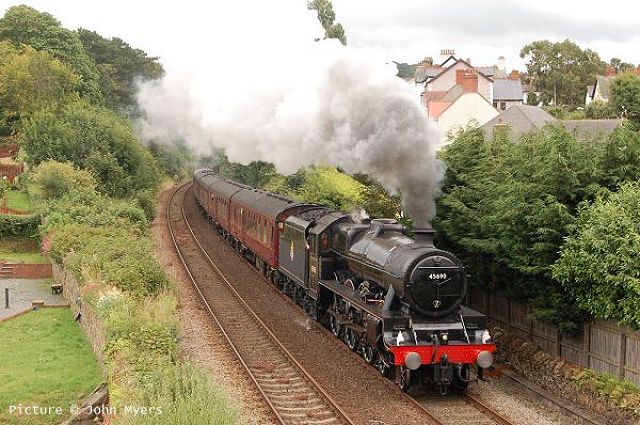
Conwy (John Myers).
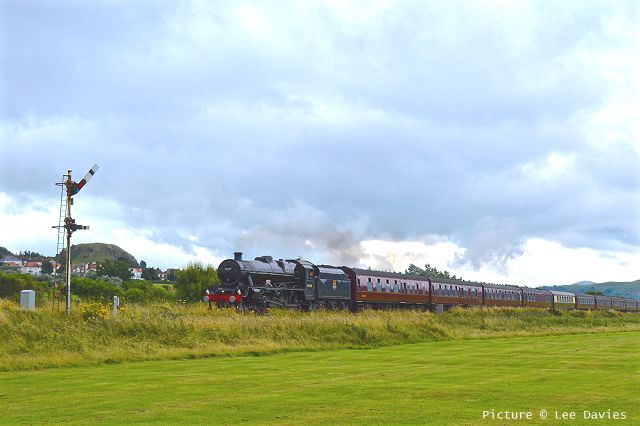
Maesdu Golf Course, Llandudno, by Llandudno station's home signal (Lee Davies).
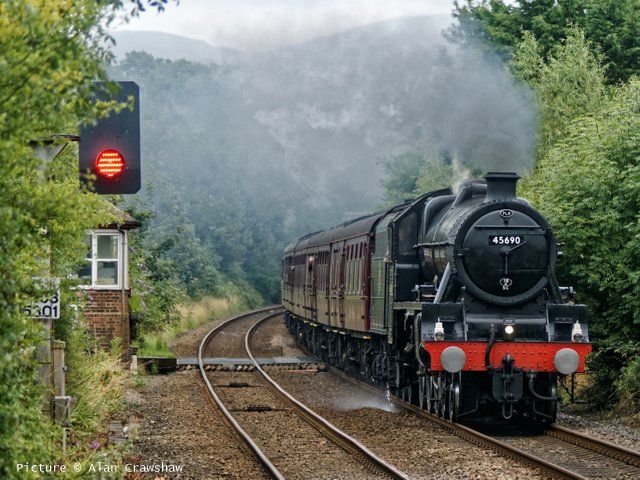
Approaching Llanfair PG (Alan Crawshaw). The modern LED signal protecting the crossing contrasts with the signalbox which dates from around 1870, before the London and North Western Railway developed its familiar standard style.
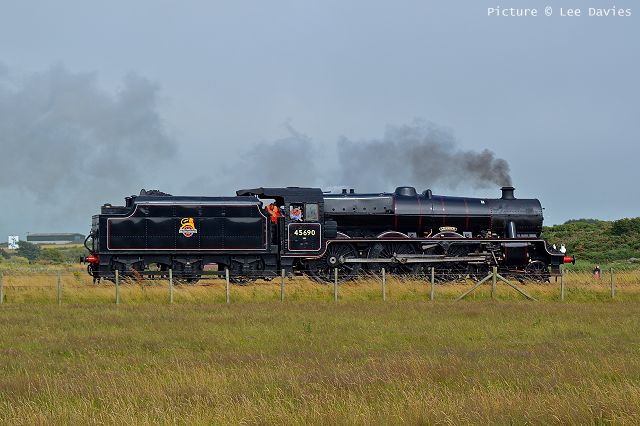
After arrival at Holyhead, Leander ran back to the triangle at Valley to turn (Lee Davies). The repaint in British Railways black helps to distinguish Leander from other preserved 'Jubilees' but on the other hand, creates a resemblance to the more common 'Black 5' type. The larger driving wheels with their 'splashers' are the most obvious identification point.
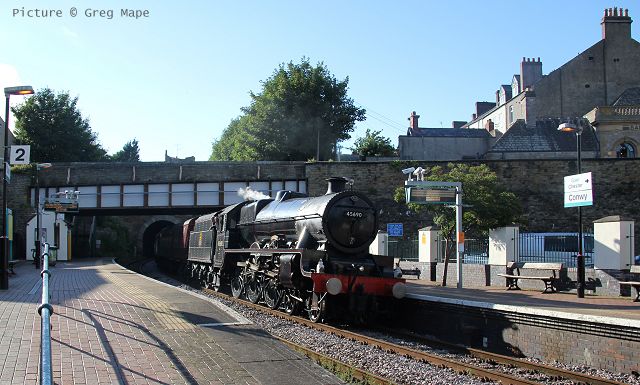
The return train at Conwy (Greg Mape)
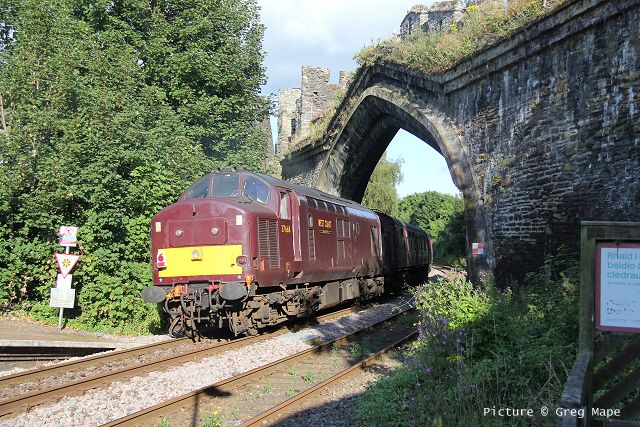
37 668 on the rear and Robert Stephenson's archway through Conwy walls (Greg Mape).
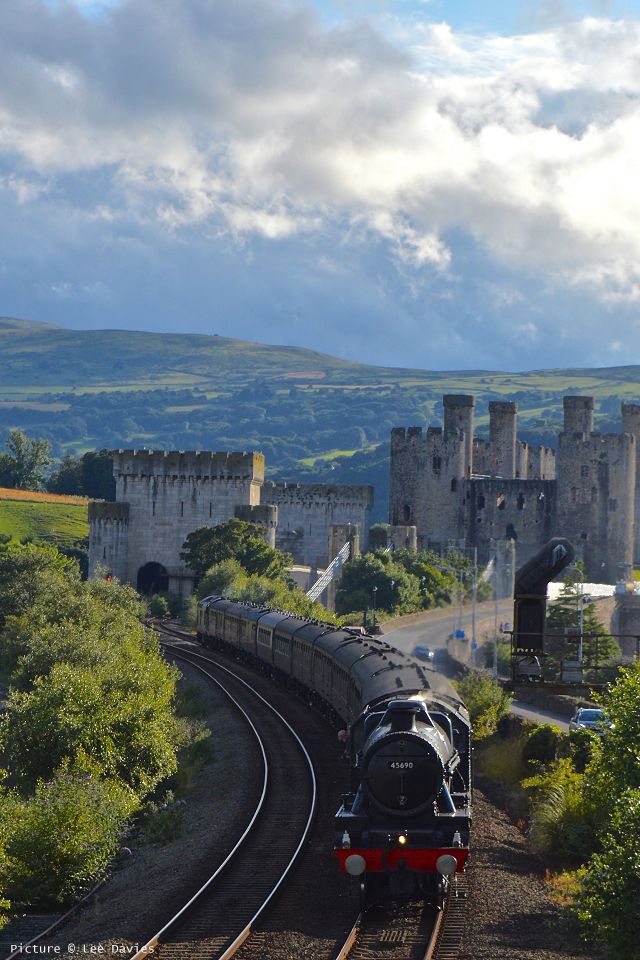
Leaving the Conwy Tubular Bridge and approaching Llandudno Junction (Lee Davies).
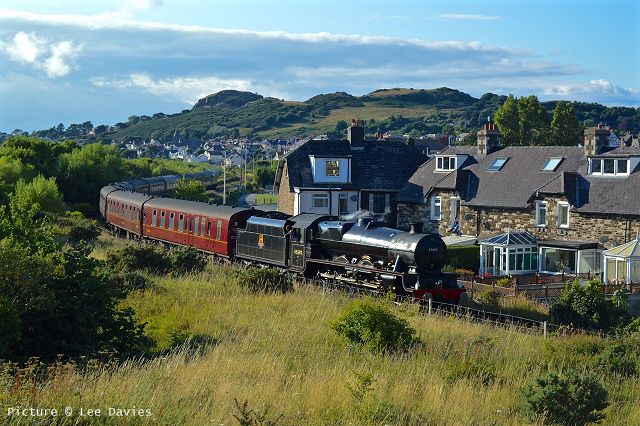
From Llandudno Junction, the train was 'dragged' by the Class 37 backwards down the Llandudno branch to collect the passengers who had alighted there (Lee Davies). The shunting moves at Holyhead on these occasions are more complex than one might think, as the Support Coach has been moved to the other end of the rake of coaches in order to stay with the loco.
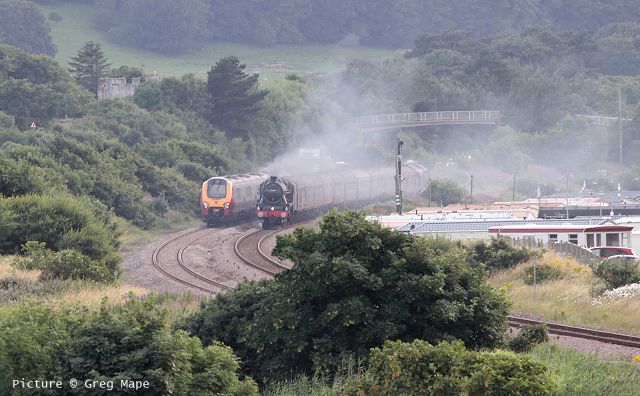
Passing one of the Jubilee's modern successors near Gwrych Castle (Greg Mape).
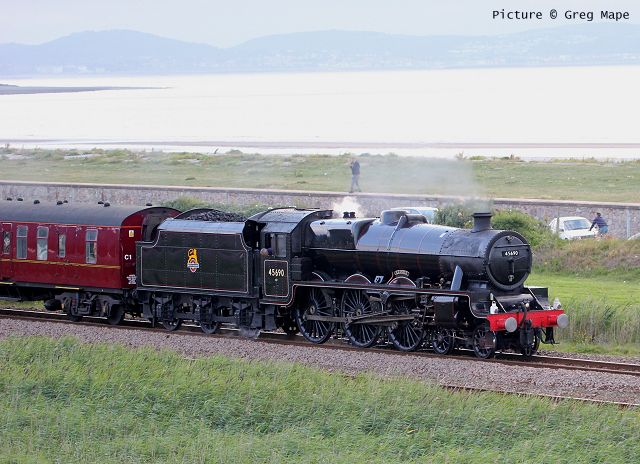
Abergele, with precarious photographer in the background (Greg Mape)
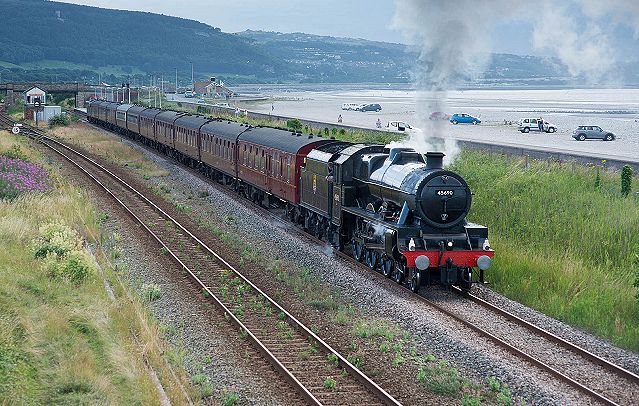
Abergele (Tim Rogers).
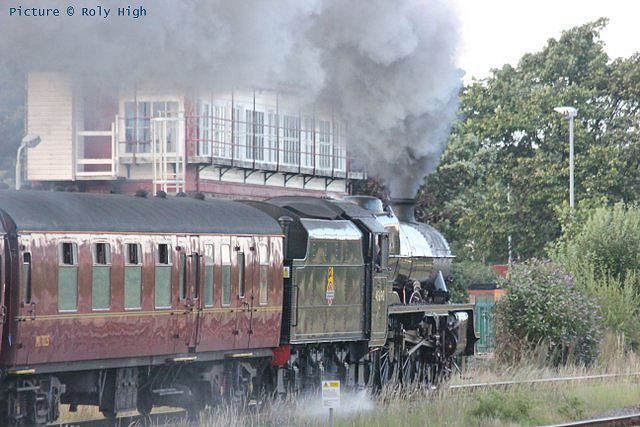
Rhyl, with smoke effects (Roly High).
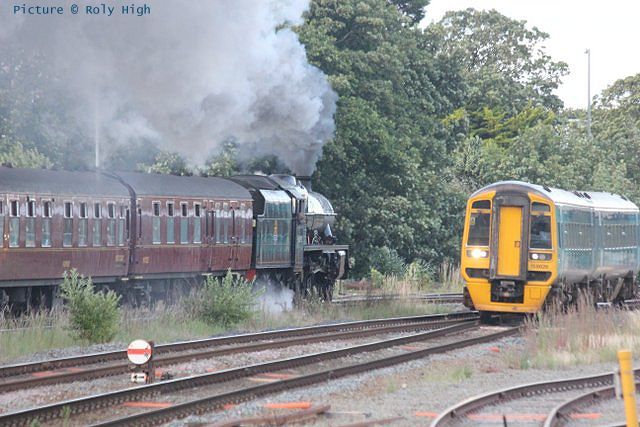
About to be 'photo-bombed' east of Rhyl by 158 826 with the ex 17.07 Birmingham International via Crewe to Holyhead (Roly High).
Picture miscellany
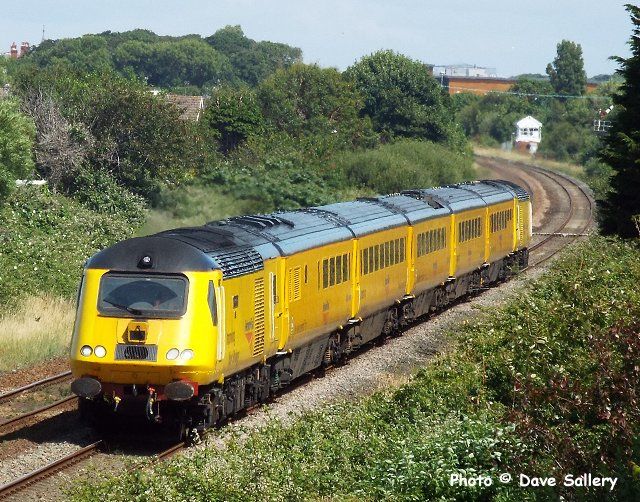
The New Measurement Train at Prestatyn, 14 July, 43 014 The Railway Observer leading (Dave Sallery).
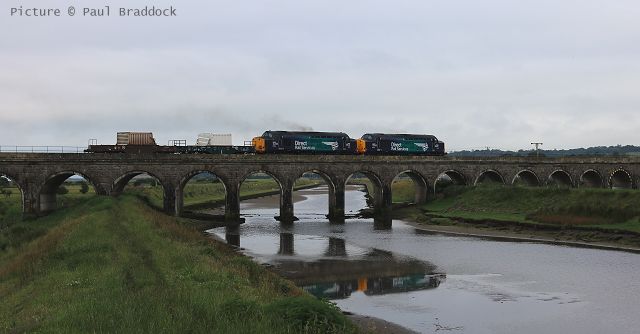
37 716 and 37 609 on 18 July on flasks westbound at 07:39 on Malltraeth viaduct (Paul Braddock)
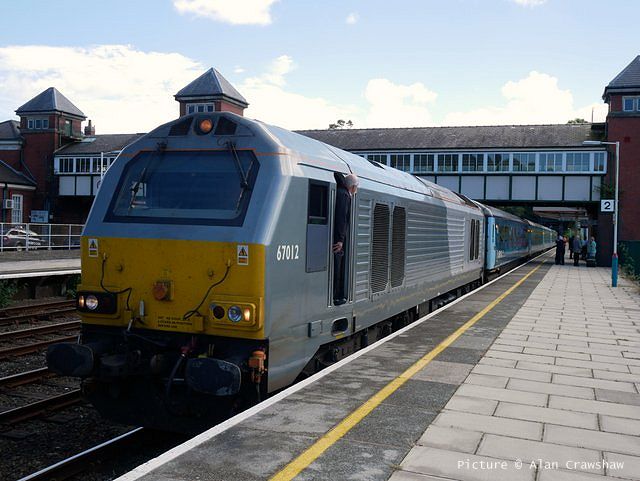
67 012 at Bangor with the 09:50 from Manchester, 18 July (Alan Crawshaw).
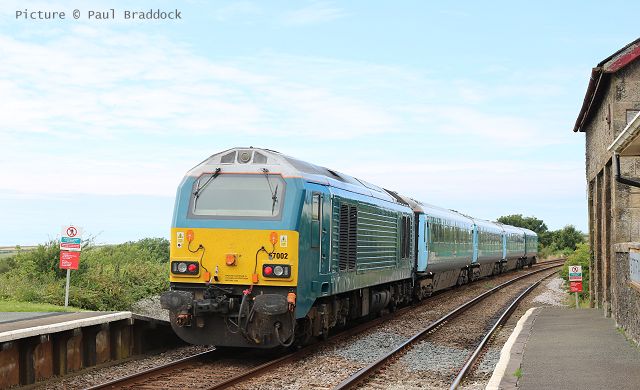
67 002 pushing the 13:06 Holyhead - Manchester through Bodorgan on 23 July at 13:42 (Paul Braddock).
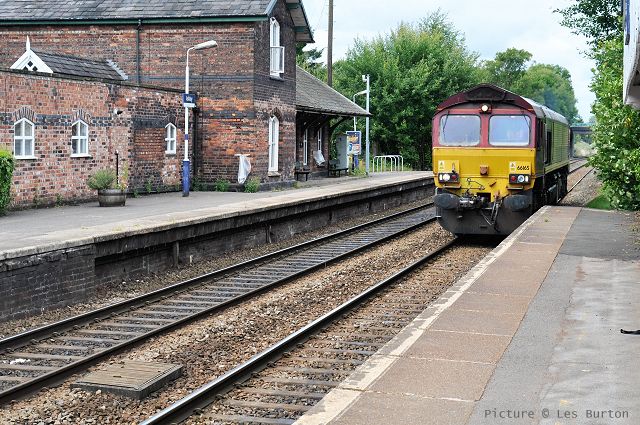
Les Burton writes: I took a trip to Ashley on Sunday 24 July afternoon hoping to see the usual Sunday afternoon Peak Forest - Lostock works stone train. However, I was surprised at 14:24 to see 66 165 light engine, as having checked Real Time trains it was not shown.'
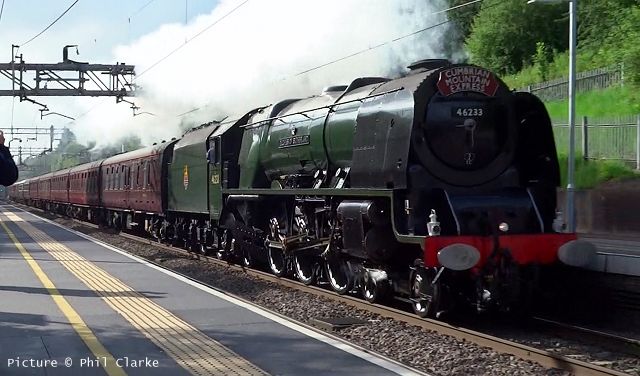
46233 Duchess of Sutherland at Hartford on 23 July with the 'Cumbrian Mountain Express' from Crewe to Carlisle. These trains now travel via the Shap route in both directions; the Settle - Carlisle line remains closed north of Armathwaite as Network Rail's repairs to an estimated 500,000 tonne earth movement continue, now thought to be complete in spring 2017. Photograph by Phil Clarke.
Llangollen's 60s weekend
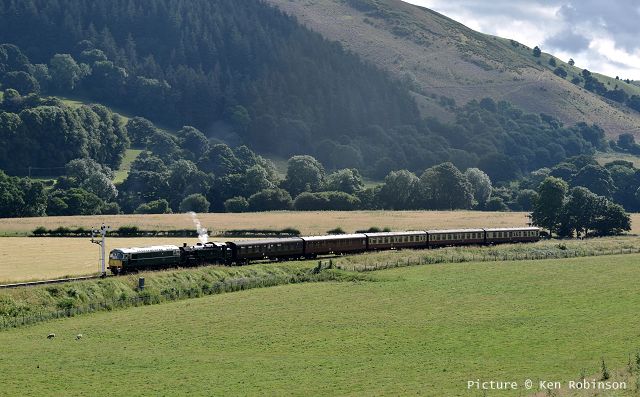
Ken Robinson was Carrog on Saturday 23 July to observe the movements of the 'mixed traction' train recalling such movements which sometimes occurred during the 1960s during the transition from Stream to Diesel. Above, D5310 leads 80072 into Carrog with the 09:00 from Llangollen ...
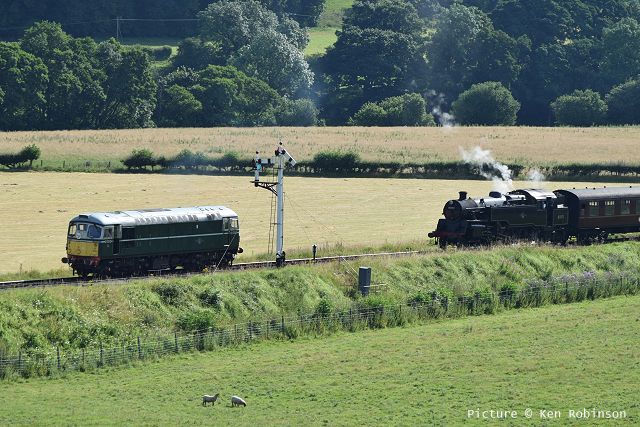
... the diesel is detached and heads into the run-round loop ...
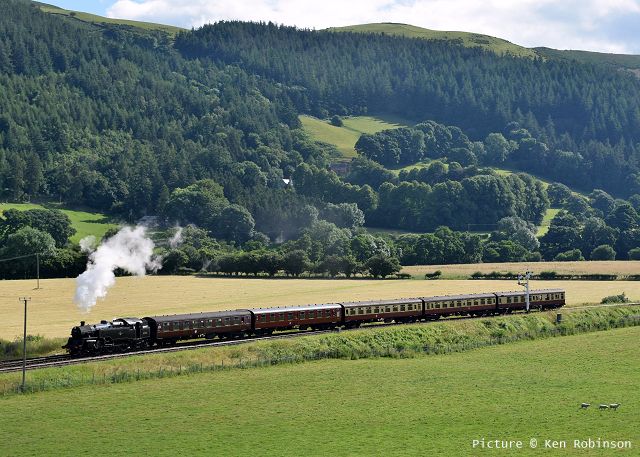
... the points are changed and 80072 brings the train into the platform...
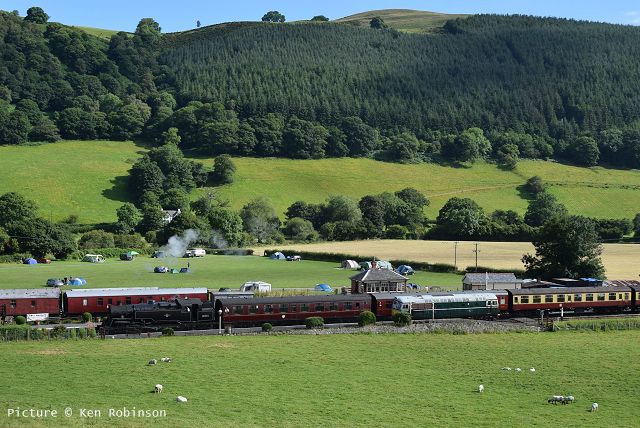
... ready to attach to the rear of the train to continue to Corwen East.
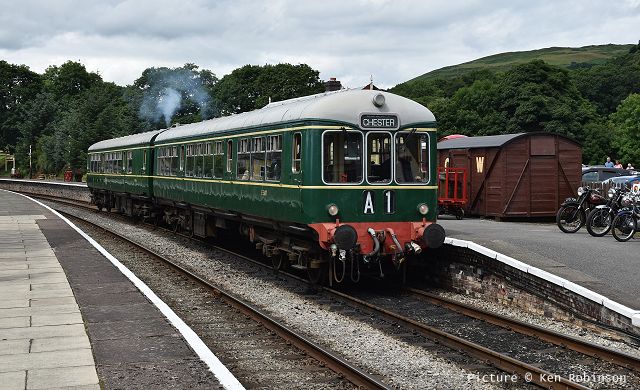
Here's the the class 109 Wickham-built DMU at Glyndyfrdwy with the 11:50 to Llangollen with some interesting classic motorbikes on the platform (Ken Robinson).
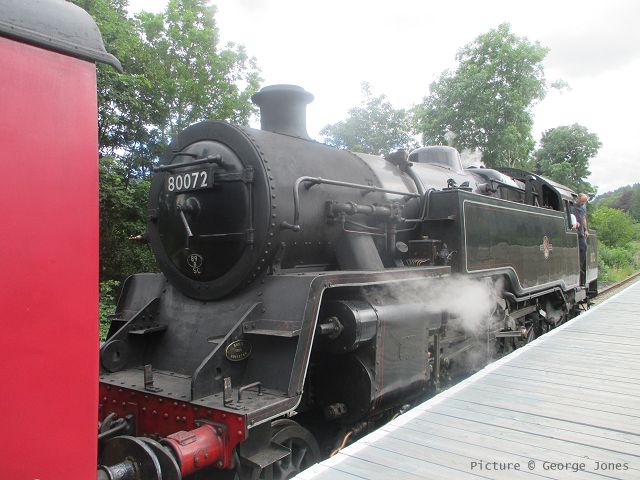
The 10:15 Llangollen - Corwen East, formed on the line's suburban coaches, was top-and-tailed by steam. It was led to Corwen East by 80072 ....
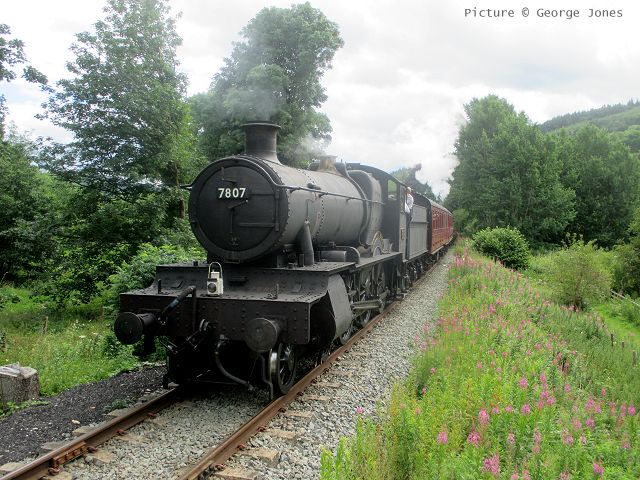
... and for the return trip, the lead engine was revealed as 7807 Compton Manor, a long lost member of the class. Actually it was 7822 Foxcote Manor in disguise and suitably grimy to represent the theme of the 1960s weekend. Pictures by George Jones.
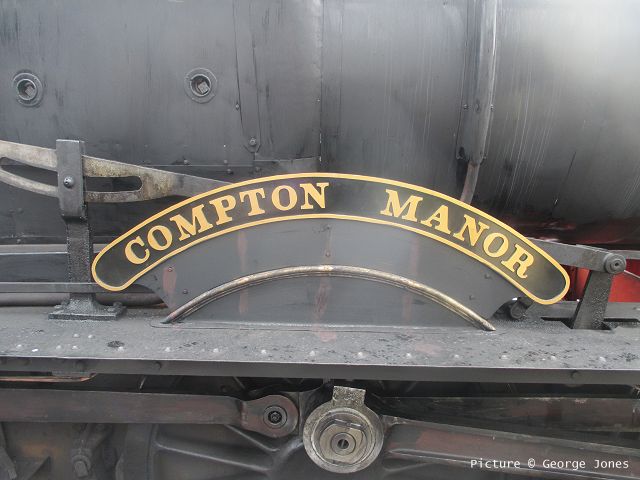
The transformation included a replica nameplate (George Jones).
The Saturdays-only 'Halton Curve' train
In our earlier item about the running of the Saturdays-only Chester - Runcorn train we mused on what the Northern unit might be doing for the rest of the day. Thanks to help from Simon Cross we can now answer the question.
The 2-car Class 156 unit starts its day at Allerton depot at 04:45, running empty to Warrington Bank Quay via a reversal at Liverpool Lime Street. Form there it works one of the day's handful of services to Ellesmere Port via Helsby before running empty to Chester to form the famous summer Saturday 07:53 to Runcorn. It then travels empty from Runcorn direct to Lime Street where it couples to another unit, booked for a Class 142 'Pacer'. This combo then works the 08:48 passenger to Warrington Bank Quay, and shuttles back and forth on that service until 16:38, when it transfers to the 'Cheshire Lines' route as the 16:55 to Manchester Oxford Road, working out and back several times on that line, including one short working from Lime Street to Warrington Central and back, until its final passenger working at 23:20 from Manchester, arriving at 00:32 and returning empty to Allerton depot after a very long day's work and over 400 miles.
Looking back: 'Bont Y Bermo' on tour - pictures by Dave Sallery
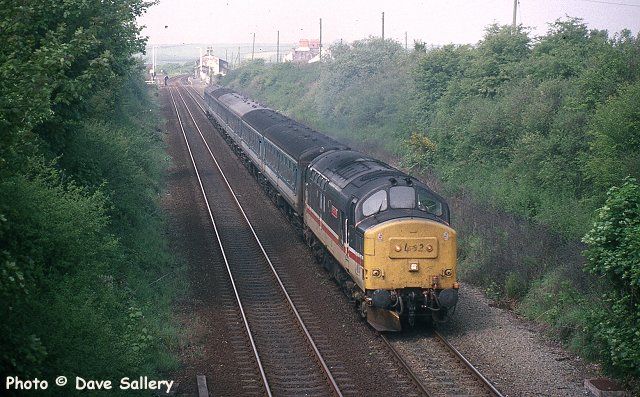
More 37/4 nostalgia, this time a look at 37 402, which spent a number of years plying the North Wales Coast. Above, on 13 May 1994 passing Bodorgan, while still wearing the so-called 'Mainline' livery which had been devised for locos which might work the occasional passenger train, distinct from 'Intercity' livery.
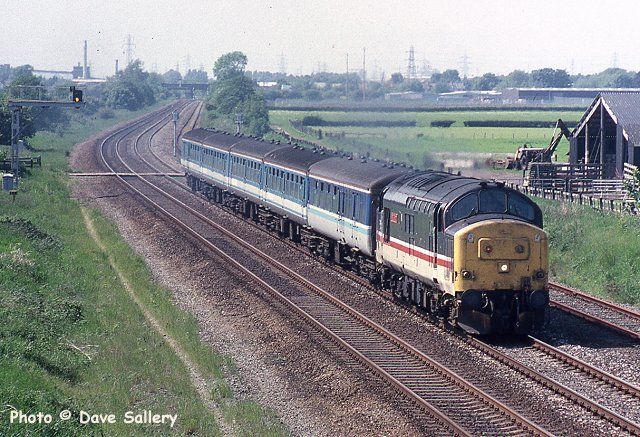
31 May 1994 at Sandycroft. Originally a Scottish loco named 'Oor Wullie', it arrived in North Wales (working from Crewe depot) in October 1993 gained the name Bont Y Bermo (Barmouth Bridge) which had originally been on 37 427 which had migrated to Scotland. Note the former NSE coaches, as mentioned in our 37 429 item above. The front coach, a first-class compartment example with brake van area, has already been repainted.
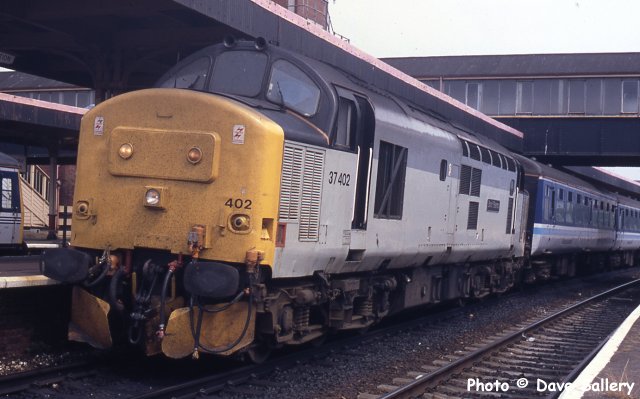
For some reason it never received Regional Railways livery, but by the time it was photographed at Llandudno Junction on 10 July 1995 it had gained the 'triple grey Railfreight' livery, but without the accompanying symbols and logos, and black background to the nameplate.
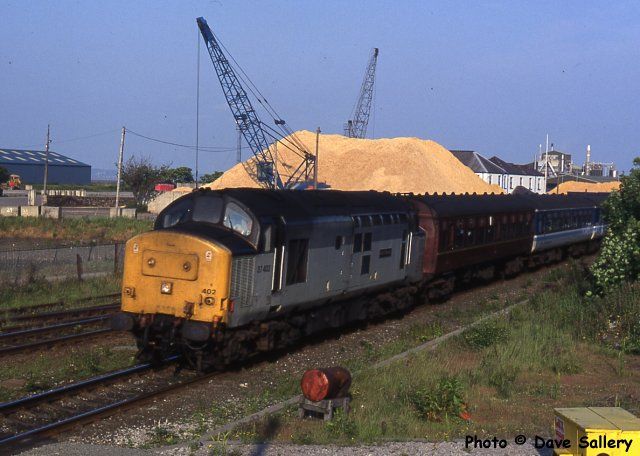
On 17 June 1996, passing a heap of sand at Mostyn Dock. By this time all the normal fleet of North Wales coaches were in Regional Railways garb, but for the summer season, the rakes were strengthened from four to five vehicles by hiring coaches from Riviera Trains. Most of these were in 'chocolate and cream' colours, but the one seen here was maroon.
Happily, 37 402 still exists, owned by DRS, named Stephen Middlemore and restored to its original 'Large Logo' livery of 1985, working passenger trains in Cumbria for Northern.
Old Colwyn, then and now - by Jim Ikin
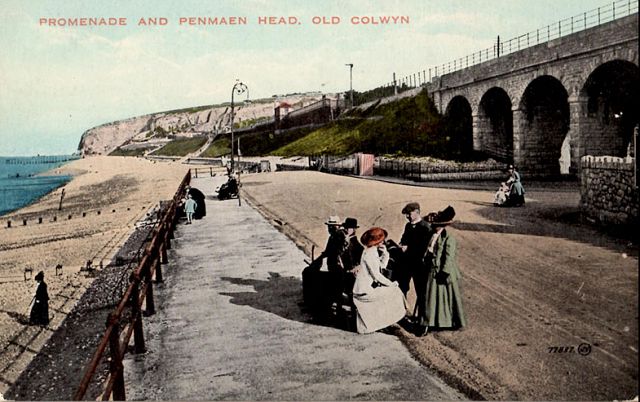
As we all know, with the advent of the internet there are quite a few photographs now available of closed stations and Old Colwyn is no exception. I collect old postcards of the North Wales coast and whilst at a fair a couple of weeks ago picked up these two. The one above - dating from 1904 - shows the cliff which has been quarried away leaving the present A55 and the outcrop that we know. It also shows shows part of Old Colwyn station, which I believe closed to passengers in 1952 and goods in 1964.
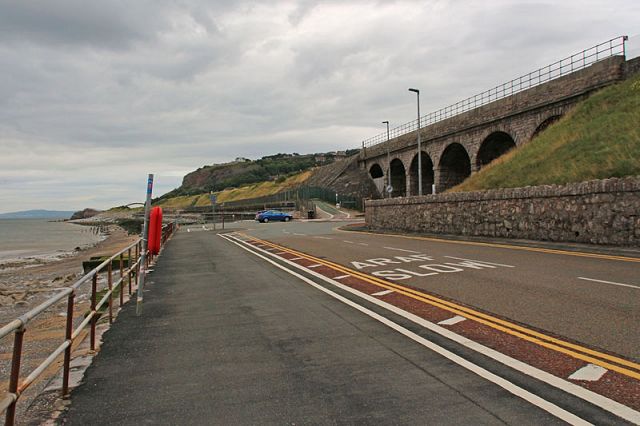
The same view today.
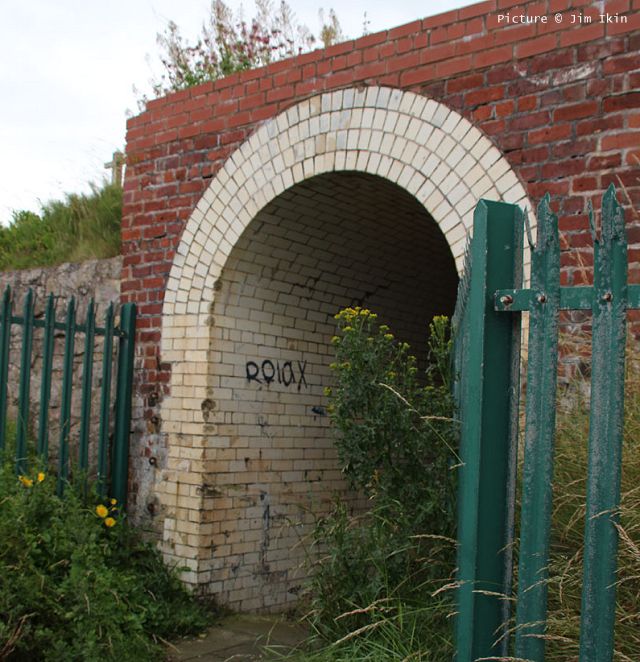
The walkway extending down the embankment to this underpass.
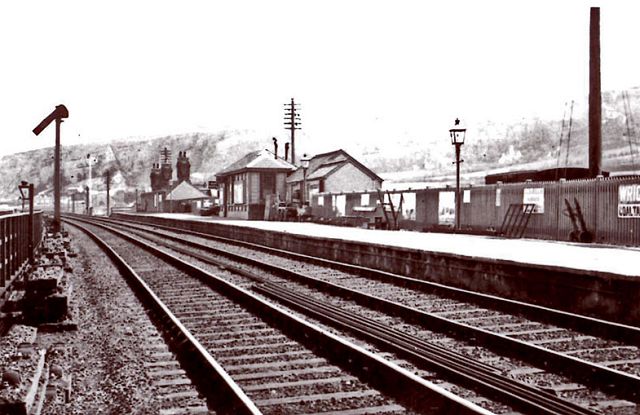
The platforms were offset; this old view is taken from the end of the seaward side. The small yard was occupied by four local coal merchants .
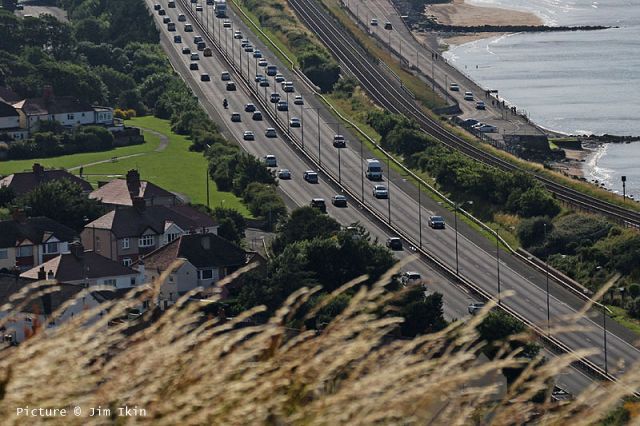
From an elevated view the yard is the grass triangle on the left by the now-truncated Station Road.
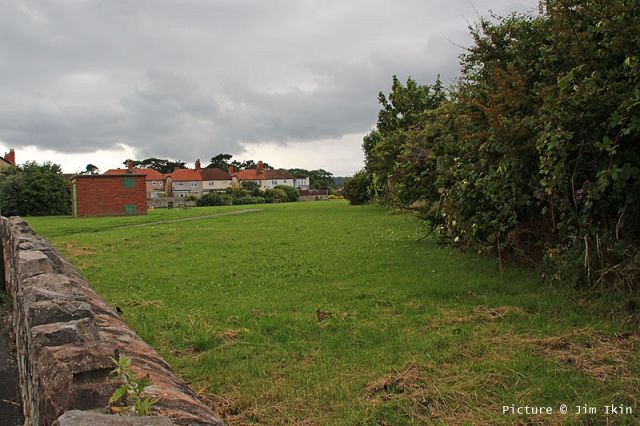
The road entrance was approximately at the place shown above.
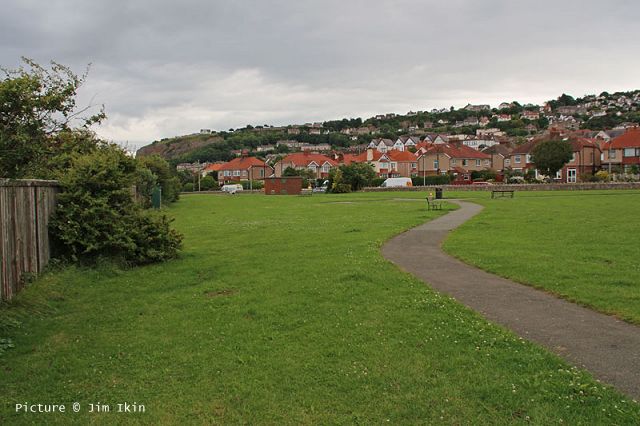
... and and the rails approximately here.
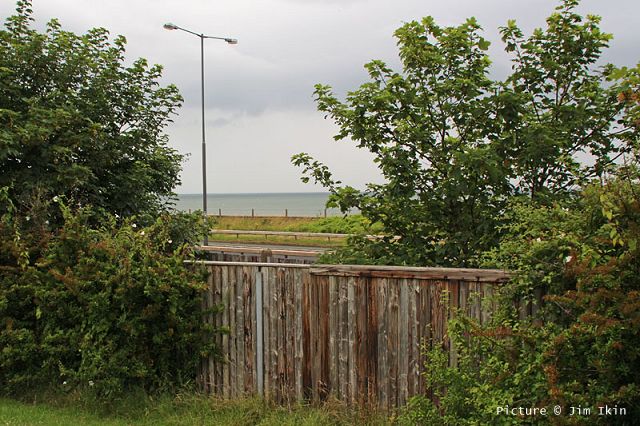
A view over the A55 of where the seaward platform would have been.
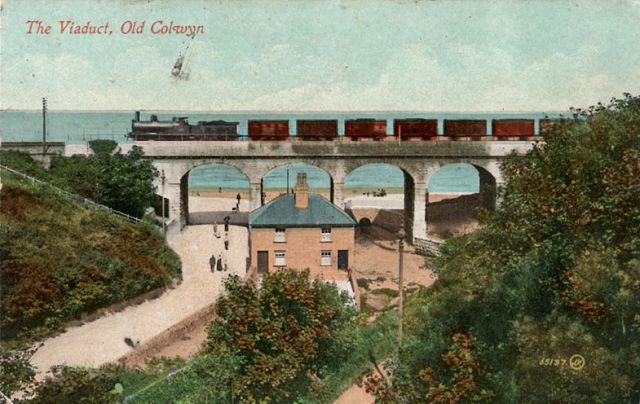
Trying to replicate the other card taken in 1909 is tricky, not just because of the presence of the A55 but the also mass of trees now in the area.
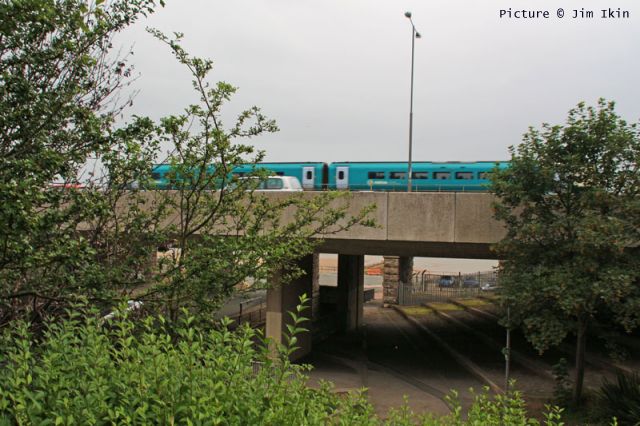
This view is really as close as is possible.
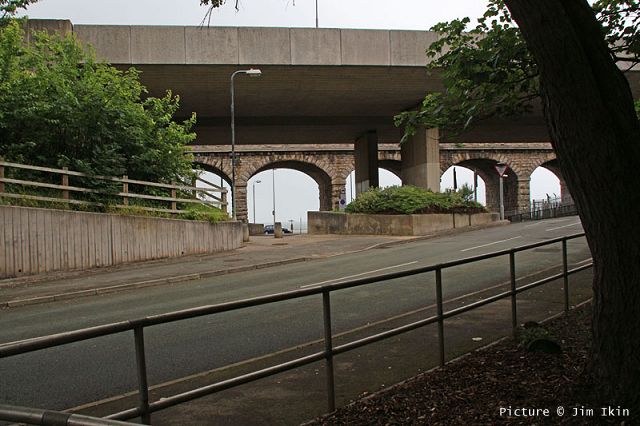
The house in the postcard would be roughly central in this view.
End of an era at Banbury - report by Chris Morrison
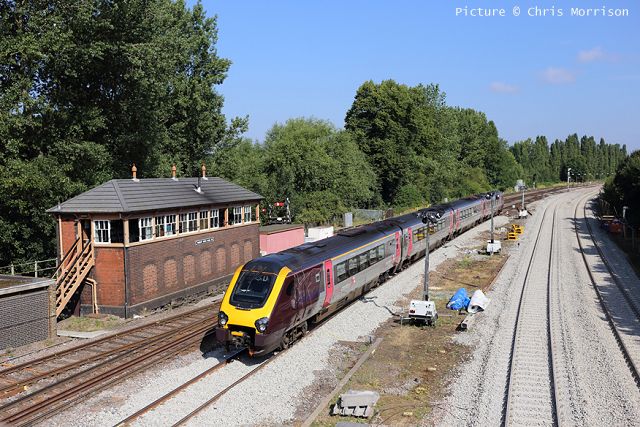
The Great Western Railway signalboxes at Banbury close on Friday 30 July as part of a major remodelling of the track layout. Above: Evidence of trackwork already completed on 23 July as a Cross Country Voyager on the 07:27 Manchester Piccadilly - Bournemouth passes Banbury North signal box, which was built in 1900 and had 95 levers.
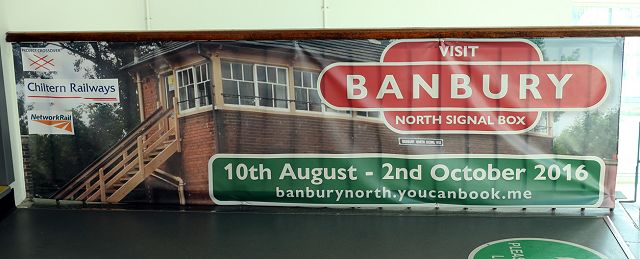
A banner at the ticket barrier at Banbury advertising trips to the North Box after it has closed. It has been given a short extended life after attempts to preserve it failed. Visits, which will last an hour, need to be booked on the website banburynorth.youcanbook.me if you can follow the somewhat contradictory instructions thereon.
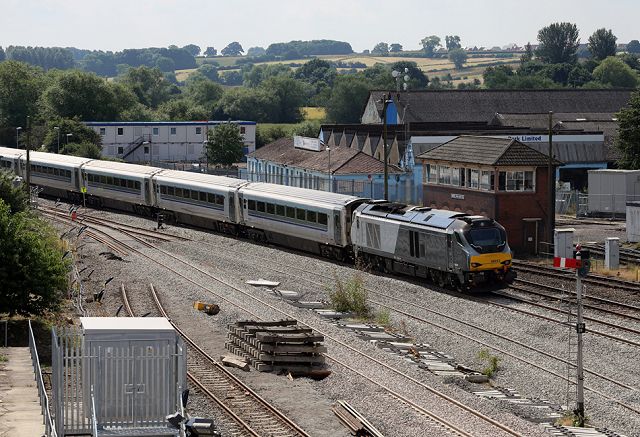
68 013 powers the 09:10 Kidderminster - Marylebone past Banbury South signalbox on 23 July. The box, built in 1908 and latterly containing 66 levers and a Solid-state Interlocking panel, will be demolished after closure to make way for new lines.
Enthusiasts Martin Creese has published a book through the Blurb publishing system about Banbury's signalboxes.
North Wales Coast home page | Archive | Previous Notice Board